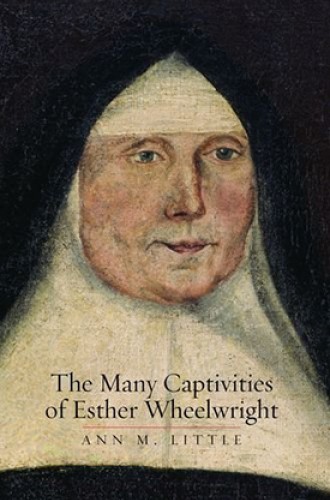Women who do things
The story of Esther Wheelwright and the communities of women and girls who surrounded her
An offhand remark can change everything. I still remember a graduate school professor’s consternation at the idea of “women’s history.” “They don’t do anything,” he protested. The comment passed without notice in a room full of male professors and students, but it took up permanent residence in my head. I was hooked, not just by his attitude problem but by the nagging reality that in the categories this well-regarded historian recognized—wars and politics and all that—he was right.
Writing women into history isn’t easy. It’s one thing to add an occasional sidebar in a textbook or praise a heroine whose brave exception proves the rule, but that doesn’t change the overall story line. The narrative still belongs to men who “do things,” driving the engines of change by waging wars and winning elections.
Read our latest issue or browse back issues.
Ann M. Little, who teaches history at Colorado State University, has taken on this challenge. Her massively and meticulously researched biography of Esther Wheelwright—born of Puritan stock, then Wabanaki captive, and finally French Catholic nun—is a story of politics and war in 18th-century North America, with women at the center. Much of the landscape is familiar: conflicts between colonial powers and cycles of frontier violence. But ultimately this is a story of one woman and, more importantly, the communities of women and girls “who surrounded her at every stage of her life,” Congregationalist, Wabanaki, and Ursuline.
Little reconstructs Wheelwright’s life mostly from offhand sources, often forced to rely on tantalizingly brief references in official accounts. Even so, the story is gripping.
Esther was only seven years old when she was taken from her frontier New England homestead in a Wabanaki raid and forced-marched through miles of wilderness. Though the specifics are elusive, we know from other surviving accounts that Esther’s new female relatives would have dressed her in deerskin and broadcloth and given her a new name. The likely possibility is “Mali,” the Wabanaki pronunciation of Marie. She also became a Roman Catholic. Jesuit missionaries had begun evangelizing the tribe in the late 17th century, but her tutors would have been other women. “After all,” Little writes, “it was they who were the experts in turning strangers into kin.”
Esther’s life took another dramatic turn five years later, when the Jesuit missionaries brought her to Quebec and enrolled her in an Ursuline school. It’s unclear whether her Wabanaki family voluntarily relinquished her or died of disease or famine—not unlikely during those violent times. Even murkier, Esther apparently skirted French and English prisoner exchange laws that required the return of children under the age of 12. Clearly, however, she flourished in her new surroundings. In 1713, “Esther Anglaise,” as she appeared in the school roster, entered the order as a novitiate. Taking on yet another name and another set of clothes, she reemerged as Sister Marie-Joseph de l’Enfant Jésus, now swathed in a long black mantle and white veil.
The story does not end there. This war captive, so poor that the Ursulines partially waived the financial requirement for her acceptance into the order, became mother superior of the convent in 1760. A portrait she likely commissioned herself, now hanging in the Massachusetts Historical Society, shows a woman fully in control of her circumstances, her serene expression radiating sober judgment and spiritual conviction.
But this is no simple success story. Wheelwright’s life, as Little reconstructs it, was a series of different “captivities,” not just as kidnapping victim and cloistered nun but as a woman in colonial society. On the morning of her capture, Esther would have been laced into stays, a corset-like apparatus that held her torso stiffly upright. As a Wabanaki, she had to master complex protocols governing everything from sex-segregated labor to who slept closest to the fire. As an Ursuline, she wore a habit that slowed her movements and narrowed her field of vision while she followed an unalterable routine of work and prayer.
Yet this is no tragedy either. Though Wheelwright’s life “may look like a great deal like captivity to modern, secular readers,” it was not, as Little explains, that different from what most of us still experience: a successive interplay of choice and circumstance. The history textbook heroine, self-actualizing against all odds, is true to neither the complexities of the past nor those of the present. The “often porous boundaries between liberty and constraint, freedom and captivity” persist.
In fact, most women’s biographies do not follow a simple trajectory like those of the Founding Fathers’ grand march through history. For one thing, as Wheelwright’s story demonstrates, the historical source material is most plentiful at the beginning and end of life, in birth and obituary records. Like many other women of the past, Wheelwright left few personal clues behind: no journal, no diary, no brilliant correspondence with an admiring associate. Little’s ingenuity at reconstructing Wheelwright’s daily life is often astonishing—she can tell us what she would have eaten for breakfast at the convent or the weather on a given day. Yet no amount of careful research can tell us how this intriguing woman felt or what she believed. The records simply do not exist: Wheelwright’s interior life is forever inaccessible.
This is not Little’s fault, of course, but readers do feel the loss. Certainly this tenacious, perhaps brilliant woman wrestled with ideas, especially theological ones. For all Little’s careful attention to Wabanaki cosmologies and Catholic piety, she delves only briefly into Wheelwright’s Puritan intellectual inheritance, which would have given the captive plenty to think about as she crossed repeatedly into alien religious and cultural territory. We can never know how Wheelwright made moral sense of things, but readers might wish Little had explored that topic more than she does. In our own disjointed times, they might find Wheelwright’s 18th-century life both odd and achingly familiar.







